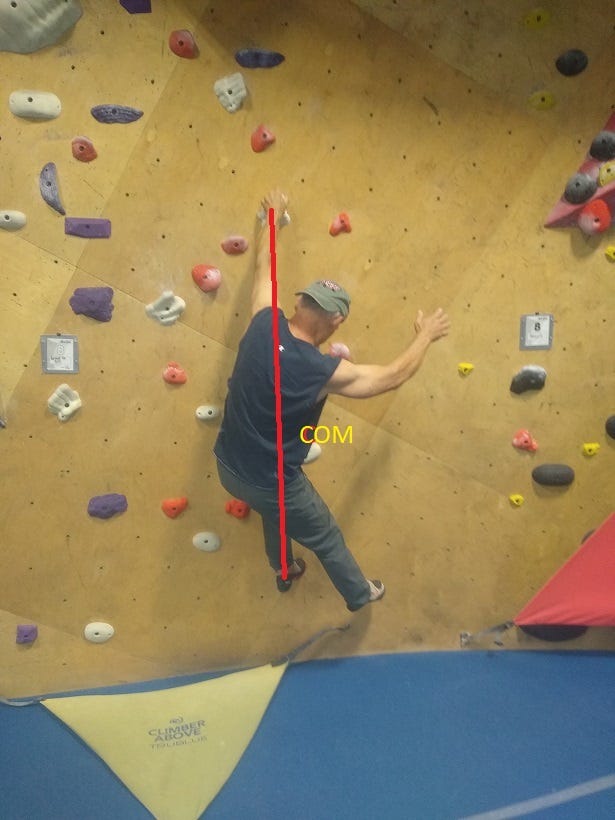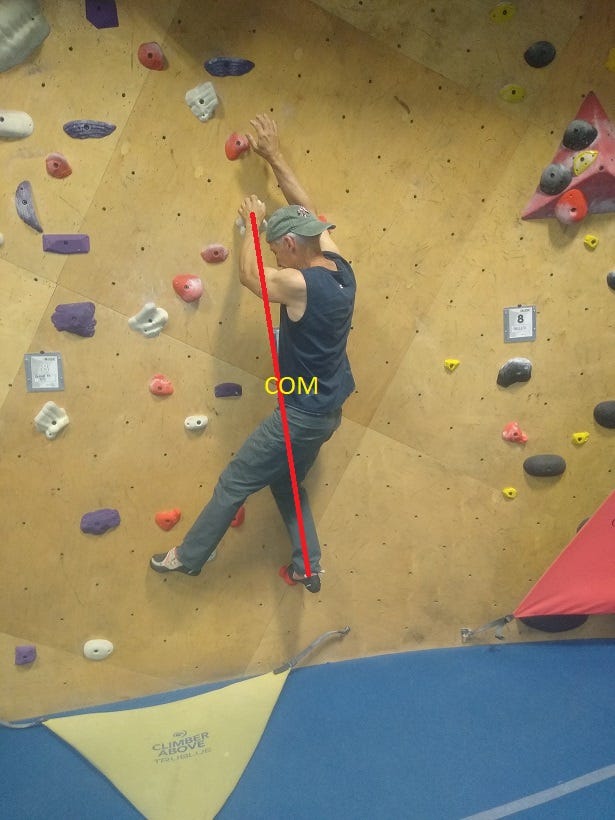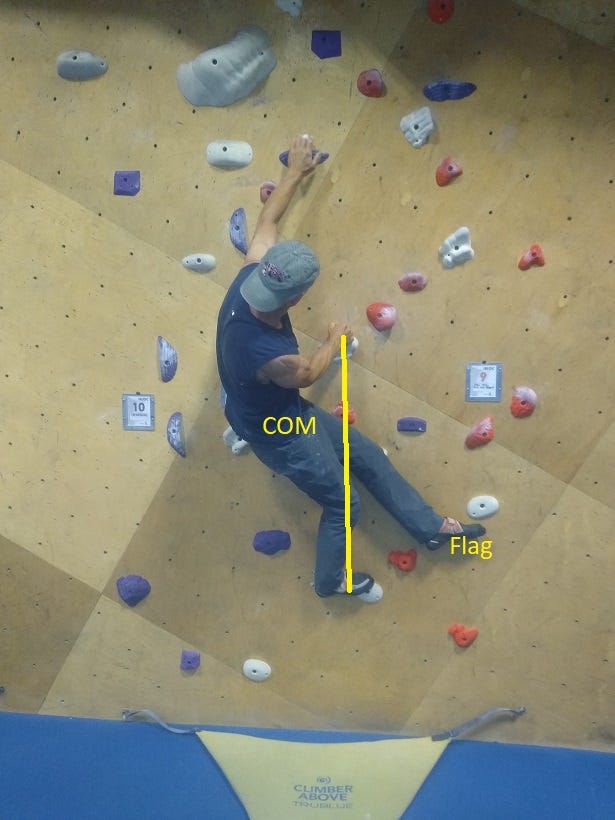I stumbled across yet another YouTube video purporting to teach face climbing technique. OMG. The guy was so confident as he described several not-necessarily-wrong but basically irrelevant things to some newbie. It was painful to watch. I couldn't finish it.
I have never seen a good explanation of face climbing dynamics. No book, video or online discussion that I have ever seen was worth anything. I've seen plenty of things that talk around it, but never anything insightful or valuable. And that is, frankly, incredible. How could that be ? Maybe it's out there and I just haven't seen it.
How did I get interested in analyzing body mechanics you ask ? Back in the early 80s I was considered to be one of the stronger boulderers around Arizona. Deserved or not, I thought I was pretty good, and I was pretty dedicated. One day I was trying a tough problem out at Gates pass. I just couldn't do the cross-match that was required. I was scratching around with my left foot trying to find a hold to take weight off my hand. But I couldn't find much for it. The legendary boulderer Bob Murray was watching and said “Drop your left foot off completely… allow your body to feel the line of power between your left hand and the opposite foot, and position your core where it feels strongest.” I thought he was crazy, but I tried it his way. And immediately made the move.
Opposite hand and foot. Hmmm. I started watching my own and others climbing in light of that, and some principles started to emerge.
Cross-body points of contact: If you are reaching for a new RIGHT handhold, generally speaking, your LEFT hand and your RIGHT foot are your STRONG POINTS. These points are on opposite sides of your body, and a line of force drawn between them will pass through your center of gravity (or nearly so). So you are in balance.
What about the other foot ? Quite often it doesn’t matter much. I see a lot of people constantly looking for a place to put the off foot. They seem to think they just HAVE to have it on the rock (or plastic). But you really don’t need both feet in many (maybe most !) situations. So searching for a place to put it is just wasting time. Or worse. Quite often slapping the off foot on a hold ruins your ability to FEEL the proper positioning of your center between the cross-body strong points. And sometimes it will just push your butt out and ruin the angles of your cross-body points of contact (POC) relative to their holds. Keep this in mind: You are often STRONGER with just the 2 cross-body points than you are with the off foot slapped on. Try it out.
Certainly there are times when the off-foot is necessary. Sometimes you need to push off on it to get momentum to the next hold. If you are drop-kneed, you usually need both feet on to establish a vector between the feet that relieves weight from your hands. And bicycle positions, while not exactly BASIC, obviously require both feet. And there is nothing wrong with having both feet on if it feels right. Just realize that some hard moves become easier if you “lose the off foot”.
So it’s simple right ? Well not so fast. As you move up the climb, hold after hold, you must look ahead and plan what you are going to do. And in so doing, you will be in positions where you don’t have cross-body strong points. What do you do ? Perhaps the answer is: plan better.
You should be choosing hand and foot holds based on how they work into your cross-body flow, NOT just based on what is near to what limb. This may entail “stepping-through” fairly often. A step-through is where you place a foot on the other side of the other foot (or perhaps above the other foot). So if your left foot is on and you are placing your right foot, a step-through with the RIGHT would mean placing it to the LEFT of the LEFT foot (or somewhere straight above it). And usually you would be using the OUTSIDE edge of the right shoe when you did this. And this correlates with a principle of face climbing I first heard voiced by my old buddy Chris Henz… you should be using the OUTSIDE of your shoe as much as the INSIDE. Perhaps a slight over-statement, but important advice. In fact, a good exercise is to do an easy route using NOTHING BUT the outside edges of your shoes, and one hip or the other touching the wall. This will raise your awareness of cross-body movement.
In spite of good planning, you will still end up in positions where you don’t have good cross-body strong points. Let’s say your good hand is your left hand and your good foot is your left foot. Then you will likely feel like you are hinged, and your body wants to rotate right off your holds… A classic “barn door” situation.
The Barn Door. POC are left hand and left foot with line drawn between them. Center of Mass (COM) is way outside the line… climber is out-of-balance.
What can you do ? (Swap, Flag or Pop !)
1) Swap feet. If you switch your right foot for your left, you will be back in balance. If the foothold is large, swapping should be easy. If it's small, you may have to “jump-swap”.
2) Flag. Put your right foot to the LEFT of your left foot. Not on a hold necessarily, but just touching (and pushing on) the wall. You can do an INSIDE flag (flagged leg in FRONT of foot on hold), or an OUTSIDE flag (flagged leg BEHIND foot on hold). Mechanically, flagging is a way of swapping feet without actually swapping feet.
3) A quick pop. A quick dyno for the new right-hand hold so the out-of-balance time is minimized. And when you hit it, you will be cross-body again (left foot/right hand).
After a foot-swap. Now a line through the strong points (left hand / right foot) goes through the Center of Mass. Climber is in balance.
An INSIDE FLAG: Center of Mass is left of the line between strong points (right hand / right foot), but flagged foot pushes against the wall to counter the barn-door rotation. Climber is stable to reach the next left handhold. When the left hand is on the next handhold, the climber can unwind the flagged foot back to the normal position. Then he will be cross-body (left hand / right foot) and should be in balance.
An OUTSIDE FLAG: Strong points are same-side (right-hand / right-foot), so climber is out-of-balance. But barn-door tendency is countered by the flagged left foot pushing to the RIGHT of the right foot. Notice that when climber hits the next left handhold he will again be cross-body and in balance, and can then unwind the flagged foot.
It is worth noting that ANY barn-door tendency can be countered by the application of PURE STRENGTH on the same-side strong points if the holds are good enough. What good enough means depends on the individual’s actual strength. It’s like the difference between a well-oiled gate (swings easily), and a very rusty gate. Very strong contact acts like a rusty gate… the gate won’t swing. But that is not a good strategy for most climbers, and expends a lot of energy even for those that have the necessary juice. And saving juice is always a good thing when climbing near your limit.
All of the above is predicated on the assumption that the line through your strong points is more or less VERTICAL. If it is closer to HORIZONTAL, then you will not have a barn-door tendency. An example of this would be turning the lip of a roof with (say) a left hand above the lip, and a left foot heel-hooked above the lip too. Your body will be hanging down between these points, not rotating. Later on I will add some photos to illustrate this, and a few helpful thoughts about how cross-body points help in this case too.
That's enough for basics. There is a lot more to say but I'll save that for later. It's hard to describe this stuff clearly, and the subtleties are legion. And I’m not getting paid to do this.
A footnote (pun intended): just yesterday I ran across a website that mentioned cross-body stuff. So the state of instruction might not be as bad as I alluded to up top. I didn't really review it, so I'm not going to endorse it either.
……………
Update: I was watching a couple of women climb at the gym today and I realized that their biggest problem was just sheer lockoff strength. All the technique in the world was not going to solve it. (Okay, there IS a bit of technique... The closer your hand is to your shoulder, the better your lockoff.) Pullups, campusing, weight loss. All help lockoff ability. On truly easy climbs these things don’t matter so much. But once you get to (say) 10+… especially steep 10+, it starts to matter. Just a fact of climbing life.
In spite of all my blather about principles, certain people favor certain styles. My buddy Vince likes to outside flag instead of swapping feet. My buddy Miles is the drop-knee king. Jon Winsley used to climb everything “open-hipped” (No back steps, no hip in, only using the front or inside edge of shoe. Sheer power.) They could all crush 13s or even 14s, so it's hard to criticize. But favoring a style is also limiting. I think you really want all options on the table. I personally favor foot-swaps a bit too much. I need to keep an open mind.
The Luis sanction: climbing is a SEQUENCE of moves. I have described the out-of-balance fixes above as though each position was independent of the others in a sequence of positions. Sometimes the proper fix for a given position depends upon what is coming next. This was clearly illustrated one night I was climbing with Luis in the gym. I would arrive at the crux sequence with a strong left hand and left foot. Same side POC. The best position for me was then to swap feet and grab the next right hand. But then my strong points were R-R. So I did another foot swap to get in balance to get the next LEFT hand…and melted off.
I watched Luis. He arrived at the crux with L-L also. But instead of swapping feet to get best balance, he did the quick pop (swap flag or pop !) to get the next right hand. And since he didn’t swap, he was already cross-body for the next move. He quickly made it and finished. So he started the sequence with a harder move, but ended up doing less foot movement, and so was faster and more efficient overall. I tried his way and it worked. Good lesson. Sometimes 2nd best solution fits better overall
…………………
Another principle: Climb one-handed. A long time ago I was watching a talented climber on New Wave wall at Windy Point. After almost every move he would release one of his hands and shake it out quickly as he eyed the coming holds. My partner and I did some hangboard timings and saw that we could go longer if we did NOT flame out while leaving both hands in contact. So get in the habit of releasing a hand as often as you can. If you CANNOT release a hand, you are probably close to flaming out, so you better get moving toward the next shakeout position.





Thx myk. This write-up is a pale echo of the original I wrote 30 years ago. But although I'm still interested in technique, I'm too lazy to write about it. I've had several excellent "pupils" over the years. Smart logical guys like Greg Rupp and Cres Snyder who learned quickly, and then took it further. A case of student surpassing the (master ?), which is gratifying. Greg said he used to pass out my old notes in climbing classes he taught for rocks and ropes.
I can't take any credit for Josie's excellent technique. She's been so good for so long. But if someone wants to see the proper application, they just need to watch her.
Great write up John!
You are an excellent teacher. I always learned something every time I climbed with you.